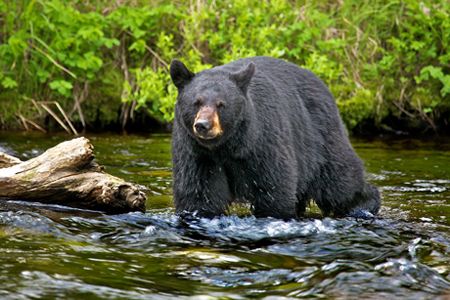Bear kidneys may hold key to new veterinary treatments
No urination during hibernation wrecks kidneysbut ursine organ regenerates.

Getty ImagesScientists at the Jackson Laboratory in Bar Harbor, Maine, are studying the kidney of the American black bear (Ursus americanus) to see if they can learn how it functions-and, hopefully, use what they discover to develop new treatments for kidney disease.
“Black bears go into hibernation in the fall with healthy kidneys,” says Ron Korstanje, PhD, a researcher at the Jackson Laboratory, in an article on the Jackson Laboratory website. “They don't urinate during hibernation, and by the time spring arrives, their kidneys are damaged and have lost most of their function.”
At that point, the bears' kidneys appear to regenerate themselves, returning to normal function during the spring and summer. “How does that happen?” Korstanje asks. “And if we figure that out, can we come up with treatments that can prevent or reverse kidney damage?”
Korstanje has distributed a number of kits to bear hunters in the region (Maine has a 16-week bear hunting season in the fall). Participants collect kidney samples from the bears they hunt and mail them back to the lab. “We expected to get maybe a dozen kits back, and we've received about 40 samples, which also include some basic information from the hunters about the bears such as gender and approximate weight and age,” Korstanje says.
Gary Striker, PhD, a nephrologist at Mount Sinai Hospital in New York, New York, is an expert renal pathologist. He examines and scores the samples, which helps Korstanje's team establish a rough timeline for kidney recovery and some estimation on the impact of age and sex.
The researchers also collaborate with Rita Seger, MD, PhD, of the University of Maine Animal and Veterinary Sciences Department, who studies bone and kidney metabolism of hibernating bears. Seger's team has provided liver samples from a bear, which Korstanje's team will use to extract DNA and ultimately assemble the world's first complete black bear genome.
Then, to see which genes are expressed at different seasons of the black bear's year, Korstanje will examine RNA samples taken from bear kidneys in the first weeks after hibernation, others from when regeneration appears to begin and others from before fall hibernation.
Korstanje says that if his lab can identify the black bear genes that have higher expression during the kidney-regeneration process, they can look into making gene expression more “bear-like,” with the ultimate goal of identifying potential drug targets for kidney patients.
Podcast CE: A Surgeon’s Perspective on Current Trends for the Management of Osteoarthritis, Part 1
May 17th 2024David L. Dycus, DVM, MS, CCRP, DACVS joins Adam Christman, DVM, MBA, to discuss a proactive approach to the diagnosis of osteoarthritis and the best tools for general practice.
Listen